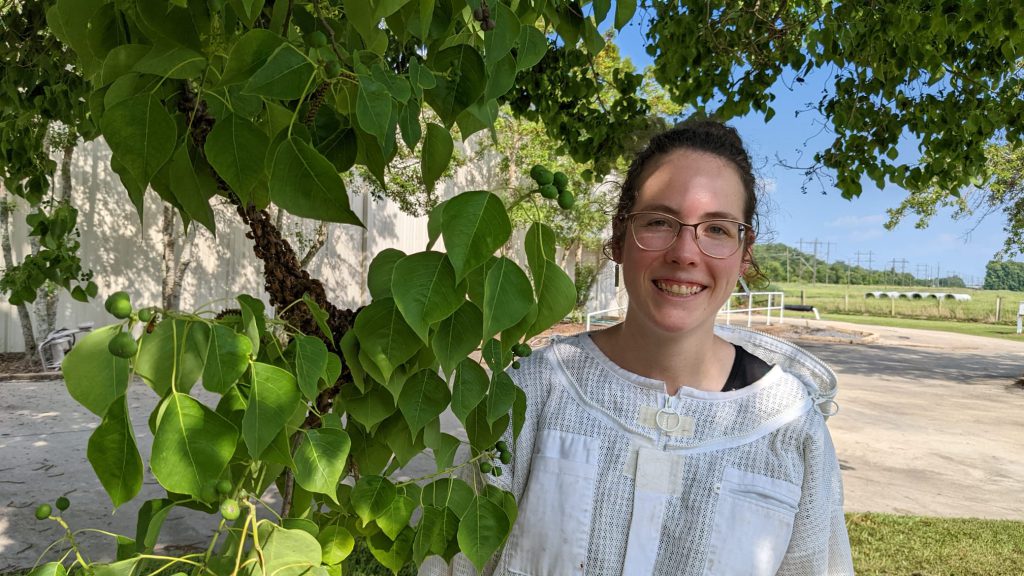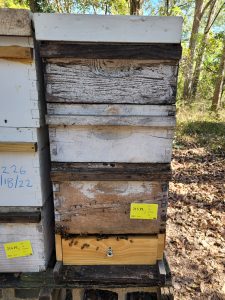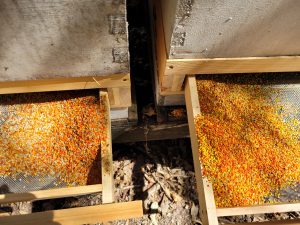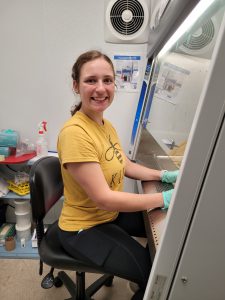 By: Elizabeth Walsh, USDA Baton Rouge
By: Elizabeth Walsh, USDA Baton Rouge
I’m Liz Walsh, a USDA-ARS (United States Department of Agriculture-Agricultural Research Service) scientist at the Baton Rouge, Louisiana location where I work in the Honey Bee Breeding, Genetics and Physiology Unit. I did my dissertation work with Dr. Juliana Rangel at Texas A&M University where I examined how pesticides impact honey bee queen health. My postdoctoral work was with Dr. Steve Pernal at the Agriculture and Agri-Food Canada in northern Alberta, and there I explored honey bee disease ecology with a particular emphasis on American Foulbrood and chalkbrood. As someone who became a beekeeper in high school, it’s very exciting to have my dream job working with honey bees full time as a Research Entomologist at the honey bee lab here in Baton Rouge.
As the newest scientist at the location, I am in the midst of setting up my research program. My ultimate career goal is to make a positive impact on the beekeeping industry. To do that, I need to have a focus on applied scientific research that is done well and then communicated to both beekeepers and scientists. I’m particularly interested in exploring how breeding initiatives can affect things like colony reproductive health, disease progression and behavior.

Hangry bee experiment colony with pollen trap
One of my current projects is particularly fun, and I’ve jokingly nicknamed it the “‘Hangry’ bee project.” As beekeepers and scientists, we know that genetics and breeding play huge roles in colony temperament—for instance, “killer bees” are hybrids of Apis mellifera scutellata and European bees. They are known for being hot tempered, although there have been a few populations that are notable exceptions, and this is explicitly attributed to their genetic background. Similarly, specific honey bee stocks that have come from different breeding efforts also have reputations for gentle or hot temperaments. Genetics clearly play a role in honey bee colony temperament and behavior (Avalos et al., 2020).

Hangry pollen
However, there is data that suggests the environment that colonies are in also plays a role in their temperament (Rittschof and Robinson, 2013). Anecdotally, it was a memorable realization as a second year beekeeper to realize that the reason my very first split was so mean probably wasn’t because of a mean queen, but instead because I had lovingly located them close to the house—directly downwind of the chimney, which meant they were getting smoked constantly. That’s probably enough of a disturbance to annoy any colony. There is also more recent empirical data, specifically from Clare Rittschof’s lab in Kentucky, that shows chronic disturbances impact the way colonies behave (Harrison et al., 2019).
In the “hangry” bee project, I’ve taken a yard of honey bee colonies and standardized their populations and colony resources, then I’ve put pollen traps on them. Half of the colonies have traps that are turned on and collecting pollen from the colonies’ foragers, which deprives the colonies of pollen. The other half of the colonies in the yard are the control colonies which have their traps off, so their foragers are able to bring pollen into the colony. We conducted behavioral and molecular assessments of the colonies and their individuals weekly to see if the ones deprived of pollen behave more aggressively than their control counterparts. We’ve found that, independently of stock, the colonies that were deprived of pollen became more aggressive (e.g. showed more aggressive behaviors like racing around the frame, stinging, etc.) than the non-pollen deprived colonies. This can help us shed some light on why different stocks of bees behave differently than their breeding or reputation suggests they would, and it is important when we consider breeding criteria.
Another set of experiments that I am working on centers around chalkbrood, an opportunistic fungal parasite that infects and kills older larvae in a colony. I’m curious about a potential treatment substance that we may use to control chalkbrood outbreaks, as the traditional advice to simply “keep strong colonies” is inadequate for dealing with chalkbrood outbreaks.

Paidon Gravois
The chalkbrood experiments have three parts: two in the lab and one in the field. The first laboratory experiment is currently ongoing. We are seeing if chalkbrood (or Ascosphaera apis) can grow on growth media containing control media/no dose, low dose, medium dose and high dose of our anti-fungal compound of interest. This work is being done with an undergraduate student from LSU, Paidon Gravois, who is pictured here with one of the plates we grow chalkbrood on. The next step will be to graft larvae into plates we keep in the lab, and subject the larvae to different conditions: control conditions, chalkbrood, anti-fungal compound and chalkbrood+the anti-fungal compound. This is known as an in vitro experiment, as the bees are being reared inside incubators in the laboratory rather than in colonies in the field. If the in vitro experiment results look promising, then we will graduate to field experiments next Summer.
As someone whose been keeping bees for 15 years, the beekeeping industry and community are both very important to me, and I hope you’ve enjoyed the news from the newly formed Walsh Lab. I encourage you to email me with questions: Elizabeth.m.walsh@usda.gov.
References
Avalos A, Fang M, Pan H, Lipka AE, Zhao SD, Giray T, Robinson GE, Zhang G, Hudson ME. 2020. Genomic regions influencing aggressive behavior in honey bees are defined by colony allele frequencies. PNAS. 117(29): 17135-17141. DOI: 10.1073/pnas.1922927117.
Harrison JW, Palmer JH, Rittschoff CC. 2019. Altering social cue perception impacts honey bee aggression with minimal impacts on aggression-related brain gene expression. Scientific Reports. 9:14642. DOI: 10.1038/s41598-019-51223-8.
Rittschof CC and Robinson GE. 2013. Manipulation of colony environment modulates honey bee aggression and brain gene expression. Genes, Brains, and Behavior. 12(8). DOI: 10.1111/gbb.12087.








